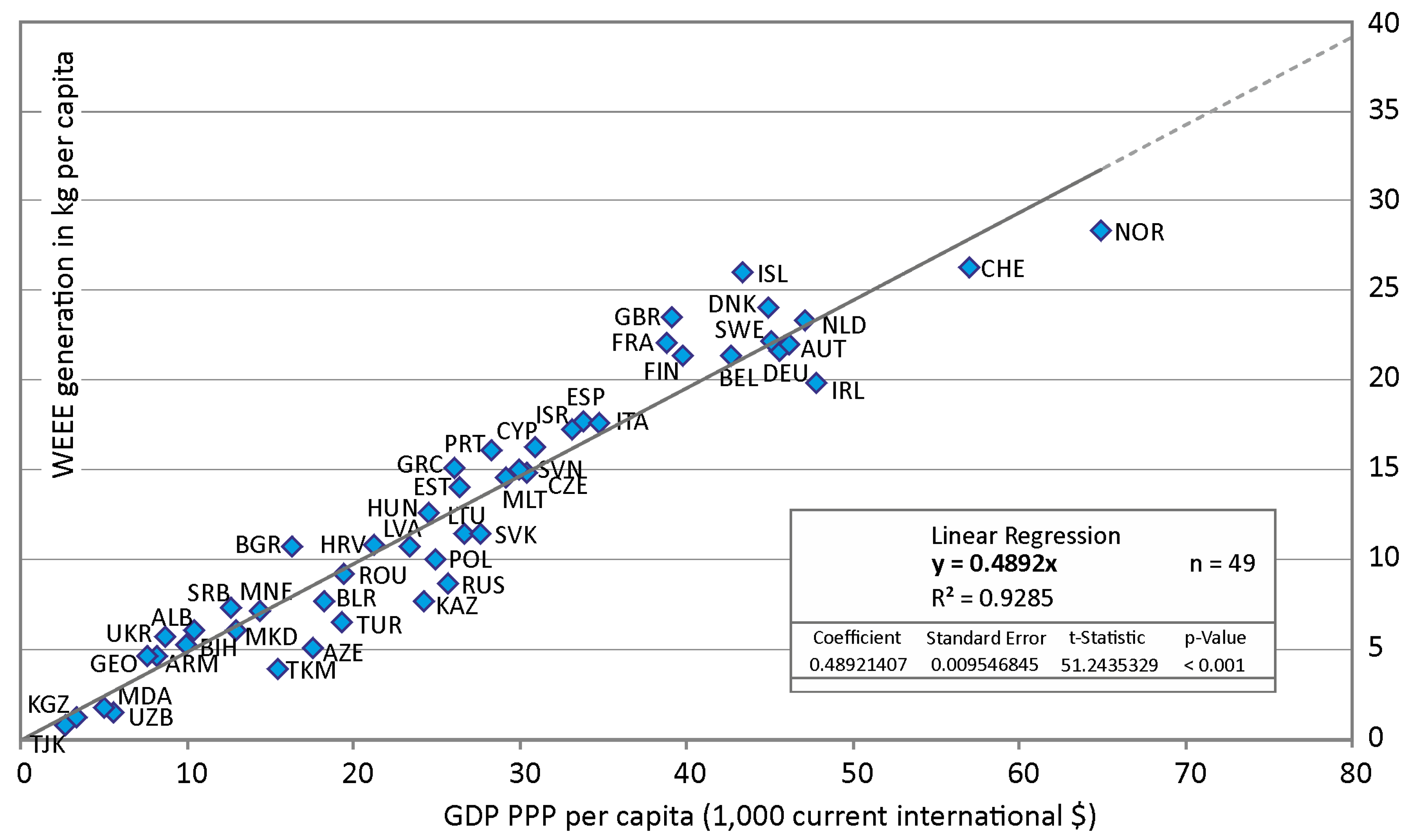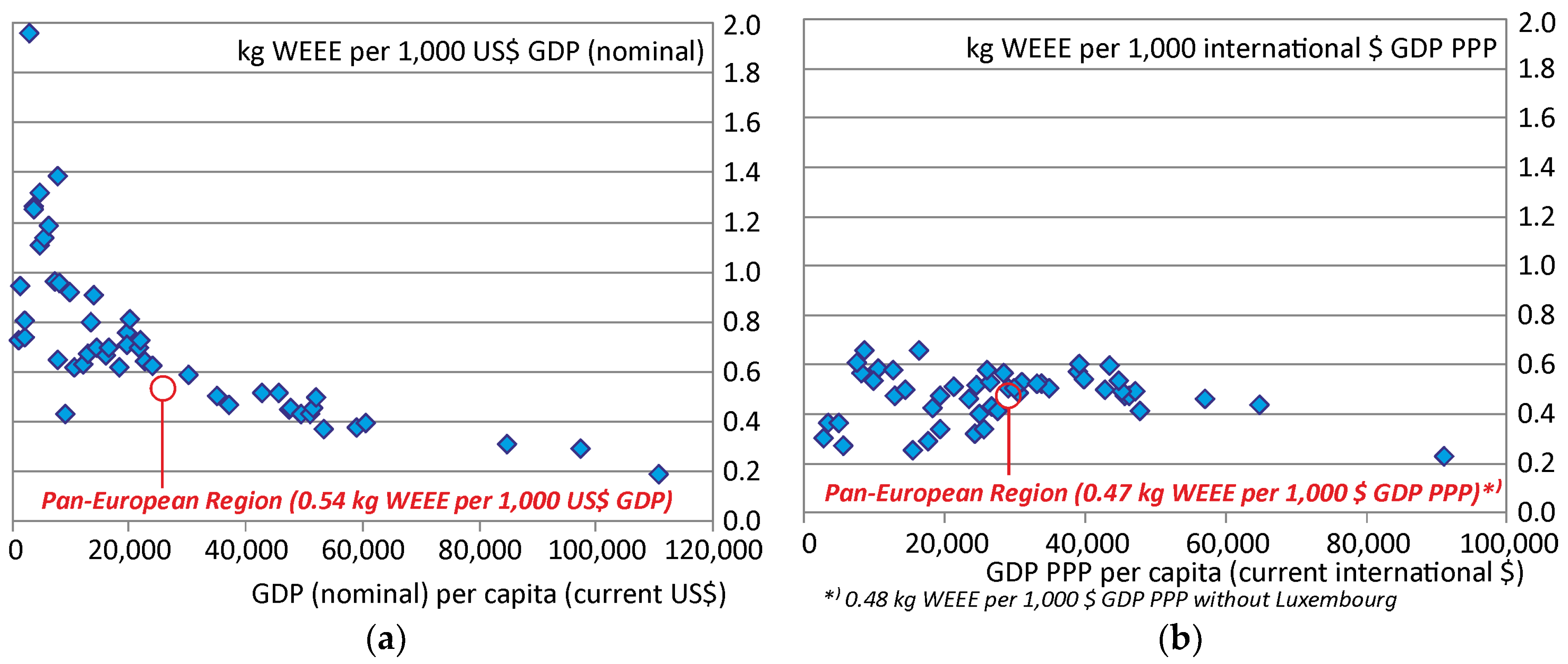The Link between e-Waste and GDP—New Insights from Data from the Pan-European Region
Abstract
:1. Introduction
2. Materials and Methods
- WEEE quantity (domestic WEEE generation per capita) against nominal GDP (per capita) of the country
- WEEE quantity (domestic WEEE generation per capita) against GDP at purchasing power parity (GDP PPP; per capita) of the country
3. Results
3.1. WEEE Generation and GDP
3.2. Linear Correlation between WEEE Generation and GDP PPP
- y: annual WEEE generation in kg per capita, and
- x: annual GDP PPP per capita in thousand current international $
3.3. WEEE Intensity
4. Discussion
5. Conclusions
Acknowledgments
Author Contributions
Conflicts of Interest
References
- United Nations Environment Programme. Global Environment Outlook 5 (GEO5)—Environment for the Future We Want; United Nations Environment Programme: Nairobi, Kenya, 2012; Available online: http://www.unep.org/geo/geo5.asp (accessed on 9 August 2016).
- United Nations Environment Programme; United Nations Economic Commission for Europe. GEO-6 Assessment for the pan-European Region; United Nations Environment Programme and United Nations Economic Commission for Europe, UNEP: Nairobi, Kenya, 2016; Available online: http://web.unep.org/geo/assessments/regional-assessments/regional-assessment-pan-european-region (accessed on 19 January 2017).
- Debnatha, B.; Roychowdhury, P.; Kundu, R. Electronic components (EC) reuse and recycling—A new approach towards WEEE management. Procedia Environ. Sci. 2016, 35, 656–668. [Google Scholar] [CrossRef]
- Tanskanen, P. Management and recycling of electronic waste. Acta Mater. 2013, 61, 1001–1011. [Google Scholar] [CrossRef]
- Ongondo, F.O.; Williams, I.D.; Cherrett, T.J. How are WEEE doing? A global review of the management of electrical and electronic wastes. Waste Manag. 2011, 31, 714–730. [Google Scholar] [CrossRef] [PubMed]
- Baxter, J.; Lyng, K.-A.; Askham, C.; Hanssen, O.J. High-quality collection and disposal of WEEE: Environmental impacts and resultant issues. Waste Manag. 2016, 57, 17–26. [Google Scholar] [CrossRef] [PubMed]
- Van Eygen, E.; De Meester, S.; Tran, H.P.; Dewulf, J. Resource savings by urban mining: The case of desktop and laptop computers in Belgium. Resour. Conserv. Recycl. 2016, 107, 53–64. [Google Scholar] [CrossRef]
- Salhofer, S.; Steuer, B.; Ramusch, R.; Beigl, P. WEEE management in Europe and China—A comparison. Waste Manag. 2016, 57, 27–35. [Google Scholar] [CrossRef] [PubMed]
- Li, J.; Liu, L.; Zhao, N.; Yu, K.; Zheng, L. Regional or global WEEE recycling. Where to go? Waste Manag. 2013, 33, 923–934. [Google Scholar] [CrossRef] [PubMed]
- Herat, S.; Agamuthu, P. E-waste: A problem or an opportunity? Review of issues, challenges and solutions in Asian countries. Waste Manag. Res. 2012, 30, 1113–1129. [Google Scholar] [CrossRef] [PubMed]
- Ylä-Mella, J.; Pongrácz, E. Drivers and constraints of critical materials recycling: The case of indium. Resources 2016, 5. [Google Scholar] [CrossRef]
- Cucchiella, F.; D’Adamo, I.; Koh, S.C.L.; Rosa, P. Recycling of WEEEs: An economic assessment of present and future e-waste streams. Renew. Sustain. Energy Rev. 2015, 51, 263–272. [Google Scholar] [CrossRef]
- Khaliq, A.; Rhamdhani, M.A.; Brooks, G.; Masood, S. Metal extraction processes for electronic waste and existing industrial routes: A review and Australian perspective. Resources 2014, 3, 152–179. [Google Scholar] [CrossRef]
- Bakas, I.; Fischer, C.; Hardi, A.; Haselsteiner, S.; McKinnon, D.; Kosmol, J.; Milios, L.; Plepys, A.; Tojo, N.; Wilts, H.; et al. Present and Potential Future Recycling of Critical Metals in WEEE; Copenhagen Resource Institute: Copenhagen, Denmark, 2014. [Google Scholar]
- Rasnan, M.I.; Mohamed, A.F.; Goh, C.T.; Watanabe, K. Sustainable e-waste management in Asia: Analysis of practices in Japan, Taiwan and Malaysia. J. Environ. Assess. Policy Manag. 2016, 18. [Google Scholar] [CrossRef]
- Alsheyab, M.; Kusch, S. Decoupling resources use from economic growth—Chances and challenges of recycling electronic communication devices. J. Econ. Bus. Financ. 2013, 1, 99–107. [Google Scholar]
- Kumar, A.; Holuszko, M. Electronic waste and existing processing routes: A Canadian perspective. Resources 2016, 5. [Google Scholar] [CrossRef]
- Alsheyab, M.; Kusch, S. End of life of electronic communication devices in the context of strategies to decouple resources use from economic growth. In Proceedings of the ICTIC 2013, Zilina, Slovakia, 25–29 March 2013; EDIS Publishing: Zilina, Slovakia, 2013; pp. 133–137. [Google Scholar]
- D’Adamo, I.; Rosa, P.; Terzi, S. Challenges in waste electrical and electronic equipment management: A profitability assessment in three European countries. Sustainability 2016, 8. [Google Scholar] [CrossRef]
- Efthymiou, L.; Mavragani, A.; Tsagarakis, K.P. Quantifying the effect of macroeconomic and social factors on illegal e-waste trade. Int. J. Environ. Res. Public Health 2016, 13. [Google Scholar] [CrossRef] [PubMed]
- Lepawsky, J. The changing geography of global trade in electronic discards: Time to rethink the e-waste problem. Geogr. J. 2015, 181, 147–159. [Google Scholar] [CrossRef]
- Rucevska, I.; Nellemann, C.; Isarin, N.; Yang, W.; Liu, N.; Yu, K.; Sandnæs, S.; Olley, K.; McCann, H.; Devia, L.; et al. Waste Crime—Waste Risks: Gaps in Meeting the Global Waste Challenge; GRID-Arendal and UNEP: Arendal, Norway, 2015; Available online: www.grida.no (accessed on 21 February 2017).
- International Labour Organization. Tackling Informality in e-Waste Management: The Potential of Cooperative Enterprises; International Labour Organization: Geneva, Switzerland, 2014; Available online: www.ilo.org/sector/Resources/publications/WCMS_315228/ (accessed on 21 February 2017).
- Lundgren, K. The Global Impact of e-Waste: Addressing the Challenge; International Labour Organization: Geneva, Switzerland, 2012; Available online: www.ilo.org/sector/Resources/publications/WCMS_196105/ (accessed on 21 February 2017).
- Hagelüken, C.; Lee-Shin, J.U.; Carpentier, A.; Heron, C. The EU circular economy and its relevance to metal recycling. Recycling 2016, 1, 242–253. [Google Scholar] [CrossRef]
- Friege, H. Review of material recovery from used electric and electronic equipment-alternative options for resource conservation. Waste Manag. Res. 2012, 30, 3–16. [Google Scholar] [CrossRef] [PubMed]
- Agamuthu, P.; Cooper, J.; Herat, S. Dilemma in re-use and recycling of waste electrical and electronic equipment. Waste Manag. Res. 2012, 30, 1111–1112. [Google Scholar] [CrossRef] [PubMed]
- Alavi, N.; Shirmardi, M.; Babaei, A.; Takdastan, A.; Bagheri, N. Waste electrical and electronic equipment (WEEE) estimation: A case study of Ahvaz City, Iran. J. Air Waste Manag. Assoc. 2015, 65, 298–305. [Google Scholar] [CrossRef] [PubMed]
- Li, J.; Zeng, X.; Chen, M.; Ogunseitan, O.A.; Stevels, A. “Control-Alt-Delete”: Rebooting solutions for the e-waste problem. Environ. Sci. Technol. 2015, 49, 7095–7108. [Google Scholar] [CrossRef] [PubMed]
- Zeng, X.; Gong, R.; Chen, W.Q.; Li, J. Uncovering the recycling potential of “new” WEEE in China. Environ. Sci. Technol. 2016, 50, 1347–1358. [Google Scholar] [CrossRef] [PubMed]
- Baldé, C.P.; Wang, F.; Kuehr, R.; Huisman, J. The Global e-Waste Monitor—2014; United Nations University, IAS—SCYCLE: Bonn, Germany, 2015; Available online: http://i.unu.edu/media/unu.edu/news/52624/UNU-1stGlobal-E-Waste-Monitor-2014-small.pdf (accessed on 9 August 2016).
- Gaidajis, G.; Angelakoglou, K.; Aktsoglou, D. E-waste: Environmental problems and current management. J. Eng. Sci. Technol. Rev. 2010, 3, 193–199. [Google Scholar]
- Huisman, J. WEEE Recast: From 4 kg to 65%: The Compliance Consequences; United Nations University, SCYCLE: Bonn, Germany, 2010. [Google Scholar]
- Lepawsky, J.; McNabb, C. Mapping international flows of electronic waste. Can. Geogr. 2009, 54, 177–195. [Google Scholar] [CrossRef]
- Huisman, J.; Magalini, F.; Kuehr, R.; Maurer, C.; Ogilvie, S.; Poll, J.; Delgado, C.; Artim, E.; Szlezak, J.; Stevels, A. 2008 Review of Directive 2002/96 on Waste Electrical and Electronic Equipment (WEEE), Final Report; United Nations University: Bonn, Germany, 2007; Available online: http://ec.europa.eu/environment/waste/weee/pdf/final_rep_unu.pdf (accessed on 15 March 2017).
- World Bank. GDP per Capita (Current US$). Available online: http://data.worldbank.org/indicator/NY.GDP.PCAP.CD (accessed on 28 August 2015).
- World Bank. GDP per Capita, PPP (Current International $). Available online: http://data.worldbank.org/indicator/NY.GDP.PCAP.PP.CD (accessed on 28 August 2015).
- European Environment Agency. Resource-Efficient Green Economy and EU Policies; EEA Report No 2/2014; Publications Office of the European Union: Luxembourg, 2014; Available online: http://www.eea.europa.eu/publications/resourceefficient-green-economy-and-eu (accessed on 22 December 2016).
- Sjöström, M.; Östblom, G. Decoupling waste generation from economic growth—A CGE analysis of the Swedish case. Ecol. Econ. 2010, 69, 1545–1552. [Google Scholar] [CrossRef]
- European Commission. Country Report Luxembourg 2016; Commission Staff Working Document; European Commission: Brussels, Belgium, 2016; Available online: http://ec.europa.eu/europe2020/pdf/csr2016/cr2016_luxembourg_en.pdf (accessed on 1 January 2017).
- Szigeti, C.; Toth, G.; Szabo, D.R. Decoupling—Shifts in ecological footprint intensity of nations in the last decade. Ecol. Indic. 2017, 72, 111–117. [Google Scholar] [CrossRef]
- Schandl, H.; Hatfield-Dodds, S.; Wiedmann, T.; Geschke, A.; Cai, Y.; West, J.; Newth, D.; Baynes, T.; Lenzen, M.; Owen, A. Decoupling global environmental pressure and economic growth: Scenarios for energy use, materials use and carbon emissions. J. Clean. Prod. 2016, 132, 45–56. [Google Scholar] [CrossRef]
- Mattila, T. Any sustainable decoupling in the Finnish economy? A comparison of the pathways and sensitivities of GDP and ecological footprint 2002–2005. Ecol. Indic. 2012, 16, 128–134. [Google Scholar] [CrossRef]
- Schandl, H.; Turner, G.M. The dematerialization potential of the Australian economy. J. Ind. Ecol. 2009, 13, 863–880. [Google Scholar] [CrossRef]
- Behrens, A.; Giljum, S.; Kovanda, J.; Niza, S. The material basis of a global economy—Worldwide patterns of natural resource extraction and their implications for sustainable resource use policies. Ecol. Econ. 2007, 64, 444–453. [Google Scholar] [CrossRef]
- Bringezu, S.; Schütz, H.; Steger, S.; Baudisch, J. International comparison of resource use and its relation to economic growth—The development of total material requirement, direct material inputs and hidden flows and the structure of TMR. Ecol. Econ. 2004, 51, 97–124. [Google Scholar] [CrossRef]



| WEEE Generation per Country in 1000 Metric Tons | |||||
|---|---|---|---|---|---|
| Western Europe | Central Europe | Eastern Europe and Caucasus with RUS | |||
| Germany (DEU) | 1769 | Poland (POL) | 397 | Russian Federation (RUS) | 1231 |
| The United Kingdom (GBR) | 1511 | Romania (ROU) | 197 | Ukraine (UKR) | 258 |
| France (FRA) | 1419 | Czech Republic CZE) | 157 | Belarus (BLR) | 72 |
| Italy (ITA) | 1077 | Hungary (HUN) | 125 | Azerbaijan (AZE) | 48 |
| Spain (ESP) | 817 | Bulgaria (BGR) | 77 | Georgia (GEO) | 21 |
| The Netherlands (NLD) | 394 | Slovakia (SVK) | 62 | Armenia (ARM) | 16 |
| Belgium (BEL) | 242 | Croatia (HRV) | 48 | Republic of Moldova (MDA) | 6 |
| Sweden (SWE) | 215 | Lithuania (LTU) | 34 | Central Asia | |
| Switzerland (CHE) | 213 | Slovenia (SVN) | 31 | Kazakhstan (KAZ) | 131 |
| Austria (AUT) | 188 | Latvia (LVA) | 22 | Uzbekistan (UZB) | 45 |
| Portugal (PRT) | 171 | Estonia (EST) | 19 | Turkmenistan (TKM) | 22 |
| Greece (GRC) | 171 | Cyprus (CYP) | 14 | Tajikistan (TJK) | 7 |
| Norway (NOR) | 146 | Southeastern Europe with TUR, ISR | Kyrgyzstan (KGZ) | 7 | |
| Denmark (DNK) | 135 | Turkey (TUR) | 503 | ||
| Finland (FIN) | 118 | Israel (ISR) | 138 | ||
| Ireland (IRL) | 92 | Serbia (SRB) | 56 | ||
| Luxembourg (LUX) | 12 | Bosnia and Herzegovina (BIH) | 21 | ||
| Iceland (ISL) | 9 | Albania (ALB) | 20 | ||
| Malta (MLT) | 6 | FYR Macedonia (MKD) | 13 | ||
| Montenegro (MNE) | 4 | ||||
© 2017 by the authors. Licensee MDPI, Basel, Switzerland. This article is an open access article distributed under the terms and conditions of the Creative Commons Attribution (CC BY) license (http://creativecommons.org/licenses/by/4.0/).
Share and Cite
Kusch, S.; Hills, C.D. The Link between e-Waste and GDP—New Insights from Data from the Pan-European Region. Resources 2017, 6, 15. https://doi.org/10.3390/resources6020015
Kusch S, Hills CD. The Link between e-Waste and GDP—New Insights from Data from the Pan-European Region. Resources. 2017; 6(2):15. https://doi.org/10.3390/resources6020015
Chicago/Turabian StyleKusch, Sigrid, and Colin D. Hills. 2017. "The Link between e-Waste and GDP—New Insights from Data from the Pan-European Region" Resources 6, no. 2: 15. https://doi.org/10.3390/resources6020015






